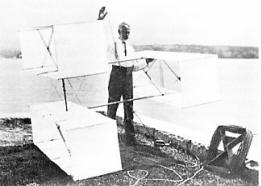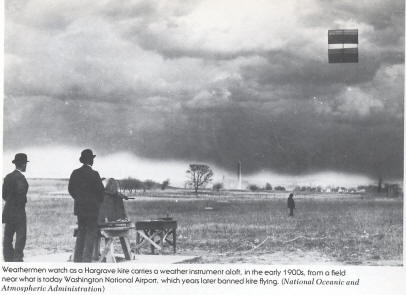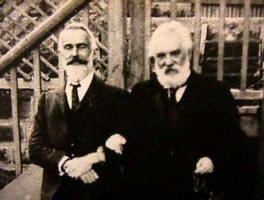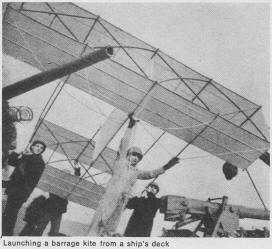 Hargrave – The
Noble Inventor
Hargrave – The
Noble InventorBy M Robinson
 1850
~ 1915 Lawrence Hargrave; versatile Australian inventor of the humble box kite,
vital stepping stone to powered flight.
1850
~ 1915 Lawrence Hargrave; versatile Australian inventor of the humble box kite,
vital stepping stone to powered flight.
This description of Hargrave from SEE THEM FLYING (Houston Peterson’s Air-Age Scrapbook 1909-1910) notes the kites were very much like the man himself. He was a modest, unassuming man, and his box kite was deceptively uncomplicated. But Hargrave was a very prolific inventor crossing over into various disciplines. He had been experimenting in Sydney, Australia with every kind of mechanical flight since 1884.
Hargrave would not obtain patents for any of his inventions. He thought that a “patentee is nothing but a legal robber” and instead wanted his inventions to be used for the betterment of mankind. This was certainly very noble, but I am not sure it was the wisest move since Hargrave was unable to afford manufacturing many his own designs. Hargrave became obsessed with both the idea of inventing a lightweight engine that would be able to power an aircraft as well as the airplane structure itself.
Over the course of thirty years Hargrave designed, built, and tested over forty engines using a variety of techniques and approaches. He also made a vast assortment of models that he powered with everything imaginable at the time…clockwork, rubber bands, gunpowder, and steam.
In 1887 Hargrave had devised the first rotary engine; a compressed-air motor in which the cylinders revolved around a stationary crankshaft. Noted scholars feel that Hargrave’s work on engines may have been as important as his aeronautical work. Mr. Hargrave was a very busy man indeed. In January 1893, he began his kite experiments that would lead to the invention of the box kite. By February 10th he was flying a kite “of three dimensions”.
 However,
it was on February 15th of 1893 that Lawrence Hargrave flew the first
true cellular kite in Sydney, Australia. Hargrave referred to his kite as
cellular (not a box kite), and appearing like “pieces of honeycomb on
the end of a stick”, which it did. In those days Hargrave’s peers called the
box kite a ‘Hargrave’.
However,
it was on February 15th of 1893 that Lawrence Hargrave flew the first
true cellular kite in Sydney, Australia. Hargrave referred to his kite as
cellular (not a box kite), and appearing like “pieces of honeycomb on
the end of a stick”, which it did. In those days Hargrave’s peers called the
box kite a ‘Hargrave’.
Then the pace really picked up! By June 1893, Hargrave was presenting a paper on cellular kites to the Royal Society of New South Wales. In August he was invited to have his paper read at the International Conference on Aerial Navigation at Chicago’s World Columbian Exposition. As1893 ended, Hargrave received correspondence from William Eddy. Eddy wrote to Hargrave seeking his blessings and permission to use his box kites for meteorological experiments in the United States.
The box kite, whose cellular construction (two cells arranged in tandem) made it the most stable and better lifting kite then anything before it. Hargrave knew that in his box kite (or cellular as he called it) he had a basic structure that could easily be adapted to gliders or airplanes. This stable design also exerted a very strong pull adding to its use as a scientific kite.
The box kite made an immediate and profound impact within the field of scientific kiteflying. For this, Hargrave was often called the father of the scientific kite.
In SCIENTIFIC KITEFLYING (The Century Illustrated Monthly Magazine, 1897), J.B. Millet wrote:
“The absence of
data much needed in order to proceed on scientific lines in devising kite forms
was due to the fact that the kite had always been considered a toy, and but for
the development of a tailless kite it would doubtless still be so regarded The
moment the weight and resistance of the tail may be safely discarded, the kite
is able to lift so much more, and self recording instruments may be attached…”
He continued, “What is wanted in a scientific kite is the maximum of lift and
the minimum of drift…the cellular construction permits bracing of parts so as to
present to the wind reasonably rigid planes…moreover the force of the wind seems
to stiffen the whole structure and compel all the parts to work together…at
first sight it is not easy to understand why these forms fly at all (box kites),
for they violate all past ideas of kites. The explanation is, however, simple.
The side planes act as fins to keep the kite in the wind. The rear cell acts as
a rudder, and actually lifts about one third as much as the front cell when both
are of the same area. This depends, however, on the distance between the front
and rear cells, which must be great enough to allow the wind to escape freely,
after it has deflected from the front cell, without interfering with the current
acting on the rear cell…”
He predicted, “The step from cellular kite to a soaring apparatus is not
a long one. Whatever the form of the perfect soaring-machine, whenever invented,
it cannot help being a good kite also, and therefore be anchored in the wind as
yachts are anchored in the stream.”
In the aviation classic, PROGRESS IN FLYING MACHINES, Octave Chanute wrote “if there be one man more then another who deserves to succeed in flying through the air, that man is Mr. Lawrence Hargrave of Sydney, New South Wales.”
There is some evidence that around 1888, Hargrave read Cayley’s triple paper of 1808-09 and learned that Cayley noted that a cambered aerofoil provides more lift then a flat wing. In 1891, Hargrave also studied Octave Chanute’s paper AERIAL NAVIGATION that Chanute presented in Chicago in 1889 on the progress of aeronautical experiments to date.
The middle of 1891 is when Hargrave began his correspondence with Octave Chanute and also begins his own experiments on curved surfaces.
I would be remiss in the topic of curved wings without mentioning Lilienthal. The influence of Lilienthal can hardly be overstated. Near Berlin, Lilienthal constructed a conical hill of earth so that he could take off downslope and into the wind, no matter which way it blew. Between 1891 and 1896 he made over 2,000 glides, some of them covering a thousand feet. Damn…that is dedication. Photographs of his flights appeared all over the world, generating great excitement and motivation to other adventurous aviation souls.
Lilienthal died in a crash just as he was about to add an engine to his gliders. Had this genius of the glider not paid the highest price one can pay for their passion, I can only imagine how different aviation history would have un-folded.
During this time (early 1890’s) Chanute was designing his own gliders, using his knowledge of bridge building to add structural strength to them. However, it wasn’t Chanute’s experience with gliders that made him an integral part of aviation history, but it was his role as aviation historian, of collector and disseminator of relevant information of the day, that he is famous for today.
Octave Chanute, who was often described as a warm delightful man, was one of America’s most successful engineers. He was a passionate and devoted student of aeronautical history who first became known for writing a series of magazine articles on aviation called Progress in Flying Machines. The articles first began in 1891 in the Railroad and Engineering Journal, and were collected and published in book form in 1894. That became the first factual and trustworthy history of man’s attempt to fly. In addition to being the most complete and well thought-out work on aeronautics to date, it also contains 14 pages on Hargrave’s experiments.
On November 12, 1894, James Swain (part time caretaker of Hargrave’s estate) assisted Lawrence Hargrave as he was lifted 16 feet in the air using four of his box kites.
 1895-96
saw Alexander Graham Bells first experiments with kites, gliders, flight-rotors,
and wings. He initially used the Hargrave box kite for his experiments. Bell
considered the box kite “a very sound design”. During this time Bell and
Hargrave corresponded and became friends. Bell traveled to Australia in 1910 to
visit Hargrave.
1895-96
saw Alexander Graham Bells first experiments with kites, gliders, flight-rotors,
and wings. He initially used the Hargrave box kite for his experiments. Bell
considered the box kite “a very sound design”. During this time Bell and
Hargrave corresponded and became friends. Bell traveled to Australia in 1910 to
visit Hargrave.
By 1896 the United States Weather Bureau had switched to a modified Hargrave box kite. They still used the Malay/Eddy design from time to time, especially in trains and very light winds, but the box was, by far, a more efficient kite. That year, Hargrave was also elected Honorary Member of The Boston Aeronautical Society. His work appeared in many journals, magazines, and newspapers of the day.
Hargrave’s box kite was illustrated in Mean’s AERONAUTICAL ANNUAL FOR 1896 and played a vital role in the development of the European aeroplane.
Within a few years, European biplane aviation designs would be dominated by Hargrave’s box kite formula. This reflected their tendency to concentrate on ‘built in stability’ versus the Wright’s focus on ‘flyability’. Demonstrating how highly the Europeans thought of Hargrave, the first professionally manufactured aircraft, made in France by the Voisin brothers was named ‘The Hargrave’.
In 1900, Cody began to experiment with his man-lifting kite system made of several of Hargrave box kites. Cody patented his winged box kite in 1901.
In June of 1909, Hargrave designed a single cell box kite with reverse curve supporting surfaces like a shallow ‘S’ (like the tilde character on the keyboard). This design provided both lateral and longitudinal stability eliminating the need for a tail plane. Hargrave designed but never built, two full size flying machines incorporating this wing. This is one of Hargrave’s lesser-known designs, and the technique is still used in hang gliders today.
 James
Wagenvoord, author of FLYING KITES IN FUN, ART, AND WAR published in 1968
wrote; “ The box’s stability and lifting power as a wind held kite were what
made possible most of the air experiments of the precedent-shattering years
between 1885 and 1910.”
James
Wagenvoord, author of FLYING KITES IN FUN, ART, AND WAR published in 1968
wrote; “ The box’s stability and lifting power as a wind held kite were what
made possible most of the air experiments of the precedent-shattering years
between 1885 and 1910.”
Long after airplanes became commonplace, Hargrave’s box kite continued to provide valuable service. In addition to many years of service for the US Weather Bureau, the cellular kite attracted the attention of aerial photographers. The camera could be attached to the box kite frame instead of being hung from below, making it much steadier. The Gibson Girl Kite and the Saul Barrage Kite, used by the military for many years, were both based on the basic Hargrave design.
Interest and loyalty to Hargrave and his cellular kite remain high to this day.
References:
Books:
KITES an Historical Survey, by Clive Hart
Flying Kites in Fun, Art, and War, by James Vagenvoord
The Penguin Book of Kites, by David Pelham
The Complete Book of Kites and Kite Flying, by Will Yolen
See Them Flying – Houston Peterson’s Air-Age Scrapbook 1909-1910
The American Heritage History of Flight (1962)
Articles:
Yearbook of the United States Department Of Agriculture 1898 - The Use of Kites in the Exploration of the Upper Air, by C. F. Marvin
The Century Illustrated Monthly Magazine, Vol. 54, No. 1, May 1897, pg 66; J. B Millet. , “Scientific Kite Flying”
Web Sites:
www.ctie.monash.edu.au/hargrave/timeline0.html
www.kites.org/aka/hargrave/hargrave.html
invention.psychology.msstate.edu/i/Chanute/library/Prog_Contents.html
Just as the development of manned flight was a huge collaborative effort by many different people from all over the world, so was this article. The very generous assistance, information, and guidance I received went well above and beyond the call of duty. Thank you to Dr. Russell Naughton of Monash University, Australia, Scott Skinner of the Drachen Foundation, Corey Jensen, Peter Lynn of New Zealand, Bob White of Canada, Peter Batchelor and Simon Freidman, both also from Australia. All provided a huge amount of material and support.
© 2002 M Robinson